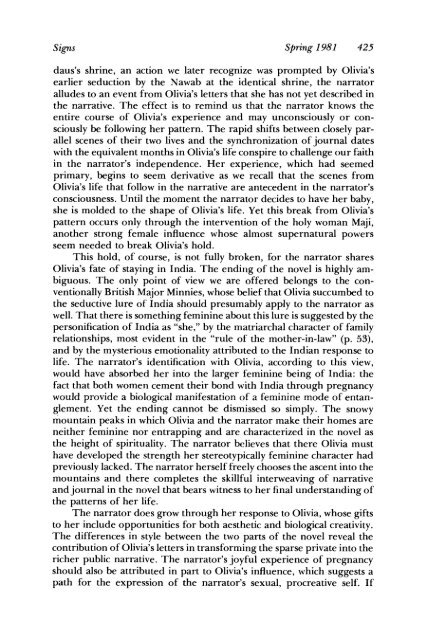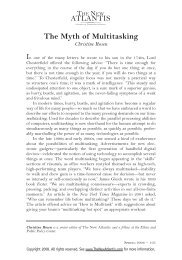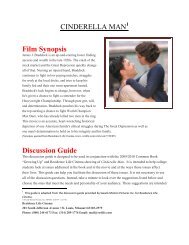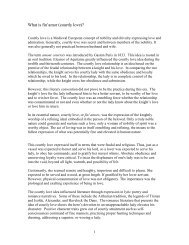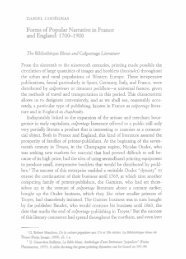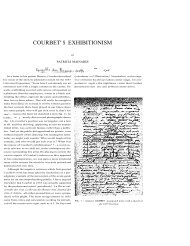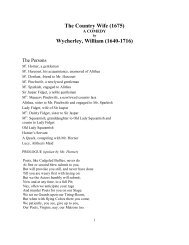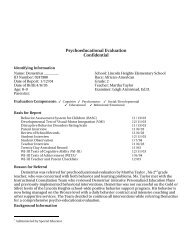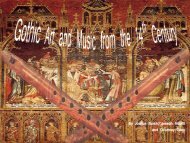(E)Merging Identities: The Dynamics of Female Friendship in ...
(E)Merging Identities: The Dynamics of Female Friendship in ...
(E)Merging Identities: The Dynamics of Female Friendship in ...
You also want an ePaper? Increase the reach of your titles
YUMPU automatically turns print PDFs into web optimized ePapers that Google loves.
Signs Spr<strong>in</strong>g I981 425<br />
daus's shr<strong>in</strong>e, an action we later recognize was prompted by Olivia's<br />
earlier seduction by the Nawab at the identical shr<strong>in</strong>e, the narrator<br />
alludes to an event from Olivia's letters that she has not yet described <strong>in</strong><br />
the narrative. <strong>The</strong> effect is to rem<strong>in</strong>d us that the narrator knows the<br />
entire course <strong>of</strong> Olivia's experience and may unconsciously or consciously<br />
be follow<strong>in</strong>g her pattern. <strong>The</strong> rapid shifts between closely parallel<br />
scenes <strong>of</strong> their two lives and the synchronization <strong>of</strong> journal dates<br />
with the equivalent months <strong>in</strong> Olivia's life conspire to challenge our faith<br />
<strong>in</strong> the narrator's <strong>in</strong>dependence. Her experience, which had seemed<br />
primary, beg<strong>in</strong>s to seem derivative as we recall that the scenes from<br />
Olivia's life that follow <strong>in</strong> the narrative are antecedent <strong>in</strong> the narrator's<br />
consciousness. Until the moment the narrator decides to have her baby,<br />
she is molded to the shape <strong>of</strong> Olivia's life. Yet this break from Olivia's<br />
pattern occurs only through the <strong>in</strong>tervention <strong>of</strong> the holy woman Maji,<br />
another strong female <strong>in</strong>fluence whose almost supernatural powers<br />
seem needed to break Olivia's hold.<br />
This hold, <strong>of</strong> course, is not fully broken, for the narrator shares<br />
Olivia's fate <strong>of</strong> stay<strong>in</strong>g <strong>in</strong> India. <strong>The</strong> end<strong>in</strong>g <strong>of</strong> the novel is highly ambiguous.<br />
<strong>The</strong> only po<strong>in</strong>t <strong>of</strong> view we are <strong>of</strong>fered belongs to the conventionally<br />
British Major M<strong>in</strong>nies, whose belief that Olivia succumbed to<br />
the seductive lure <strong>of</strong> India should presumably apply to the narrator as<br />
well. That there is someth<strong>in</strong>g fem<strong>in</strong><strong>in</strong>e about this lure is suggested by the<br />
personification <strong>of</strong> India as "she," by the matriarchal character <strong>of</strong> family<br />
relationships, most evident <strong>in</strong> the "rule <strong>of</strong> the mother-<strong>in</strong>-law" (p. 53),<br />
and by the mysterious emotionality attributed to the Indian response to<br />
life. <strong>The</strong> narrator's identification with Olivia, accord<strong>in</strong>g to this view,<br />
would have absorbed her <strong>in</strong>to the larger fem<strong>in</strong><strong>in</strong>e be<strong>in</strong>g <strong>of</strong> India: the<br />
fact that both women cement their bond with India through pregnancy<br />
would provide a biological manifestation <strong>of</strong> a fem<strong>in</strong><strong>in</strong>e mode <strong>of</strong> entanglement.<br />
Yet the end<strong>in</strong>g cannot be dismissed so simply. <strong>The</strong> snowy<br />
mounta<strong>in</strong> peaks <strong>in</strong> which Olivia and the narrator make their homes are<br />
neither fem<strong>in</strong><strong>in</strong>e nor entrapp<strong>in</strong>g and are characterized <strong>in</strong> the novel as<br />
the height <strong>of</strong> spirituality. <strong>The</strong> narrator believes that there Olivia must<br />
have developed the strength her stereotypically fem<strong>in</strong><strong>in</strong>e character had<br />
previously lacked. <strong>The</strong> narrator herself freely chooses the ascent <strong>in</strong>to the<br />
mounta<strong>in</strong>s and there completes the skillful <strong>in</strong>terweav<strong>in</strong>g <strong>of</strong> narrative<br />
and journal <strong>in</strong> the novel that bears witness to her f<strong>in</strong>al understand<strong>in</strong>g <strong>of</strong><br />
the patterns <strong>of</strong> her life.<br />
<strong>The</strong> narrator does grow through her response to Olivia, whose gifts<br />
to her <strong>in</strong>clude opportunities for both aesthetic and biological creativity.<br />
<strong>The</strong> differences <strong>in</strong> style between the two parts <strong>of</strong> the novel reveal the<br />
contribution <strong>of</strong> Olivia's letters <strong>in</strong> transform<strong>in</strong>g the sparse private <strong>in</strong>to the<br />
richer public narrative. <strong>The</strong> narrator's joyful experience <strong>of</strong> pregnancy<br />
should also be attributed <strong>in</strong> part to Olivia's <strong>in</strong>fluence, which suggests a<br />
path for the expression <strong>of</strong> the narrator's sexual, procreative self. If


